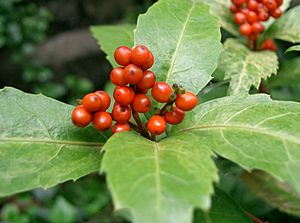Chloranthaceae facts for kids
Quick facts for kids Chloranthaceae |
|
|---|---|
 |
|
| Sarcandra glabra | |
| Scientific classification | |
| Kingdom: | |
| (unranked): | |
| Order: |
Chloranthales
R.Br.
|
| Family: |
Chloranthaceae
R.Br. ex Sims
|
| Genera | |
|
|
Chloranthaceae is the scientific name for a family of flowering plants. This plant family has four main groups (called genera), with many different kinds of plants (species) in them. These plants can be soft and green (like herbs) or woody (like small trees or shrubs).
You can find Chloranthaceae plants growing in many parts of the world. They are common in Southeast Asia, the Pacific Islands, Madagascar, Central and South America, and the West Indies.
Their flowers are often small and not very noticeable. They usually grow in clusters called inflorescences. These flowers typically do not have petals. Sometimes, they also lack sepals, which are the small leaf-like parts that protect the flower bud. Some flowers have both male and female parts (called hermaphrodite). Other plants have separate male and female flowers. The fruit of these plants is like a small berry or drupe, with a single seed inside.
Contents
What are Chloranthaceae Plants?
The Chloranthaceae family is a group of plants that produce flowers. Scientists study these plants to understand how different plant families are related. This family is quite old in terms of plant evolution. It helps us learn about the early history of flowering plants.
Different Kinds of Chloranthaceae
There are four main groups, or genera, within the Chloranthaceae family:
- Ascarina: These are usually shrubs or small trees.
- Chloranthus: This group often includes herbaceous plants, meaning they have soft, green stems.
- Hedyosmum: These are typically shrubs or small trees.
- Sarcandra: This group also includes herbaceous plants or small shrubs.
Each of these genera has its own unique features. However, they all share common traits that place them in the Chloranthaceae family.
Where Chloranthaceae Grow
These plants are found in various parts of the world. They prefer warm, tropical, and subtropical climates.
- Asia: Many species grow across Southeast Asia.
- Pacific Islands: You can find them on islands in the Pacific Ocean.
- Africa: Some species are native to Madagascar.
- Americas: They are also found in Central and South America, as well as the Caribbean.
Their wide distribution shows how adaptable these plants can be to different environments.
Unique Features of Their Flowers
The flowers of Chloranthaceae plants are quite interesting because they are different from many other flowering plants.
- Small and Simple: Their flowers are often very small. They do not have bright, showy petals like roses or sunflowers.
- No Petals: Most flowers in this family do not have petals. This is a key feature that helps scientists identify them.
- Sepals Too?: Sometimes, they even lack sepals. Sepals are usually found at the base of a flower.
- Male and Female Parts: Some flowers have both male and female reproductive parts. Other plants have separate male flowers and female flowers. This can be on the same plant or on different plants.
These simple flower structures are thought to be a sign of their ancient origins.
Images for kids
See also
 In Spanish: Clorantáceas para niños
In Spanish: Clorantáceas para niños


